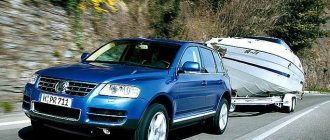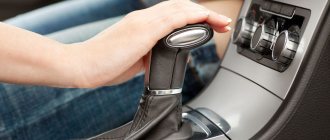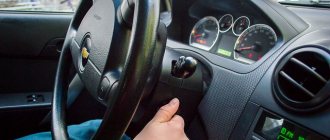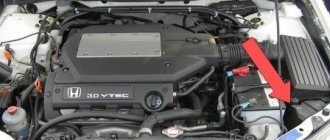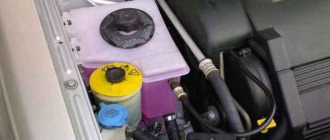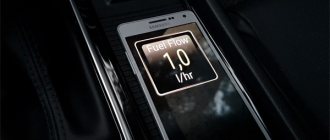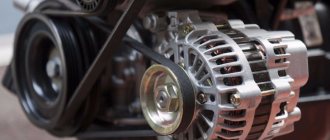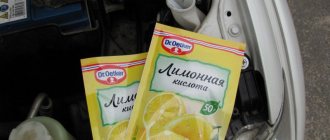The process of driving a car is greatly simplified thanks to such an addition as an automatic transmission. The driver can devote more time to the road itself, and not to the process of applying a particular speed. Even the standard and most simple devices support several driving modes. Among them there is also the so-called neutral.
The wheels do not receive torque from the engine if the shift lever in the automatic transmission is in the neutral position. Photo: autoassa.ru
The use of neutral gear is often done when the car is slowing down due to a traffic light. But the use cases for this tool have their limitations.
Many of those who use automatic transmissions may never use neutral in their entire lives. But this element is mandatory. The main purpose is to tow the car.
Information on towing rules is publicly available - just read the official operating instructions that come with the vehicle.
The instructions also state that the towing distance itself should not exceed 50 kilometers. If you need to travel a longer distance, it is recommended to use a tow truck. Or towing technology, in which the front wheels of the car are raised.
Why do you need neutral on the automatic: parking assistance
The parking lot is another place that allows the use of neutral gears. Photo: kto-chto-gde.ru
It is recommended to leave parking in neutral gear only if there are problems with the operating mode. If the car is left at neutral speed, then to start the engine, fully depress the pedal responsible for the brake.
Switching to neutral during traffic jams and before traffic lights
Drivers have many misconceptions, one of which is precisely related to the fact that when stopping at a traffic light, you need to switch to neutral mode. Especially often those who previously drove vehicles using a manual transmission think this way.
But in this case there are some peculiarities related to management.
- When the drive mode, also designated as D, is in operation, pressure begins to build up due to the torque converter of the automatic transmission. Due to the same process, torque is transmitted in the device.
- Thanks to the mode indicated above, all parts included in the gearbox are actively lubricated.
- When the accelerator pedal has not been pressed and is not used, the torque converter maintains its position in the “green zone”. In this case, the torque converter is also coated with lubricant. And no processes are carried out anymore.
When the driver switches to neutral mode, the input and output shafts open. This means that the process of lubrication of parts itself is interrupted. After the traffic light turns green, the transition to a new speed mode will become more stressful for the car, since the pressure in the system changes sharply from one level to another.
Because of this, the elements in the box move more than necessary, which negatively affects overall performance and leads to early failure.
From the same point of view, we must consider the situation when a driver finds himself stuck in traffic jams. During a traffic jam, there is no need to constantly change modes D and N with each other. If there is no traffic at all, it is permissible to simply temporarily turn off the engine, or switch to mode P - parking.
Engaging in neutral while driving
Many drivers prefer to be in the N position when the car is moving downhill. Photo: m.top54.city
You can’t turn on neutral while driving, for several reasons.
- Proper lubrication of the working units stops when the lever moves to the neutral position. And when the car is moving, this condition must be fulfilled.
- The driver has less time and opportunities to make maneuvers. For example, if it is necessary to go around an obstacle, the driver will not be able to increase speed.
- Another reason is that the pressure in the system changes too sharply. This can cause the transmission itself to fail prematurely.
So is it acceptable to switch to neutral while driving? No, such actions are not recommended.
If the car is equipped with classic automatic transmissions, then the engine can be used for braking. To calmly cope with descents, it is recommended to press the O/D button, if included. After this, the vehicle switches to using the third stage. And it will not be able to reach a speed of more than 80 kilometers per hour. If a speed of 120 kilometers per hour or more is constantly maintained, then this function is not implemented.
The selector is moved to position two when driving on steep slopes. Then the driving speed will be limited to 40-60 kilometers per hour.
The L position will be useful in several situations:
- Off asphalt roads.
- If there are steep descents with ascents.
When using L mode, the car will never accelerate more than 10-20 kilometers. This is useful during climbs as it allows you to make maximum use of the vehicle's torque.
In general, cars with automatic transmissions do not like off-roading. Or driving on roads in the winter season. There is a high probability that the wheels will start to slip. This leads to automatic transmission parts wearing out too quickly.
You should not press the gas as hard as you can if the car gets stuck in mud or puddles.
Mode 1 or Mode L are more suitable for overcoming such obstacles. It’s better to drive back a little, using the track you’ve already traveled.
If the unit is not warmed up enough, then excessive loads are unacceptable for it. The same applies to high speeds. Smooth movement during the first couple of kilometers of the journey will be useful even in the summer. At first, you should avoid sudden jerks. You need to wait until the oil warms up to the required temperature. In other types of transmissions, heating occurs even more slowly.
In winter, to warm up, the selector is specially placed in several different positions at once in a short time. But you need to linger on each one. Then the oil in the automatic transmission warms up faster and easier. You can press the brake pedal while simultaneously using the Drive mode. It is better to drive the first kilometers, activating the winter operating mode.
You will learn what you should not do with an automatic transmission from this video:
Many people think that a handbrake is not needed at all for automatic transmissions. And drivers really rarely use this device. For some, one P mode is enough. But the operating rules of any vehicle make hand brakes a mandatory element of the system. After all, sometimes it happens that the automation fails. And only manual devices help to avoid situations where too much harm is caused to surrounding people and even buildings.
The handbrake is also used if the car stops for a while, but the engine continues to run. Or when the driver leaves the cabin for a short time.
Bottom line
Neutral gear on an automatic transmission is not just a random extra detail, it is of great importance for the car. However, it is necessary to observe some operating features in order for the gearbox to serve consistently for as long as possible.
Today is the fifth video lesson on driving an automatic transmission (automatic transmission). I propose to talk about such an important aspect as neutral transmission. It seems like what to say about her? But it’s not so simple, many drivers who drive a manual transmission can often coast the car (neutral at speed), but is this possible with an automatic? Or here’s another question: is it necessary to switch to neutral at a traffic light? And in general, why do we need this automatic transmission...
First, a little definition.
Neutral gear
is
a gearbox position (not only) in which there is no transmission from the engine to the wheels, so the car does not move when the engine is running.
How to behave at a traffic light or traffic jam
Another common question is whether you need to put the gear in neutral at a traffic light or is it enough to just press the brake pedal and remain in
D mode - “drive”
?
The question is very, very difficult, thousands of different pieces of advice can be heard from various sources, and even from branded car services there is no definite opinion.
Let's think for ourselves. What any manual (user's manual) tells us.
When neutral gear is engaged, there is no connection between the input and output shafts. The output shaft is not blocked, which means the vehicle can move (towing). Therefore, neutral gear (), is mainly needed only for service transportation of the car and then according to certain rules.
Remember an automatic (automatic transmission), this is not a mechanic at all, the clutch principle here is completely different. There is no clutch disc, and the torque converter does all the work. However, when the “N” (neutral) mode is turned on, there is simply no connection between the engine and the wheels. Our donut (torque converter) rotates, but it does not connect the wheels and the engine, because the locking rings, also known as friction discs, unclench.
What happens when you move the lever to position “D” - the oil pump pumps pressure into the valve body, then the solenoid opens and gives pressure under which the friction discs (first gear) are compressed. They seem to connect two shafts (from the engine and from the wheels) and the car is ready to move, release the brake pedal and go. Afterwards, the electronics decide which friction discs (which gear) to close.
What happens when you stand at a traffic light and turn off "D" and go into "N". The clutches open, the solenoids close, and the shafts disengage. Then you again transfer from “N” to “D” and again such a complex process is repeated! I REMIND YOU AGAIN THIS IS NOT A MANUAL TRANSMISSION!
The result is that solenoids and first gear clutches wear out faster! If you turn it on once (and in a traffic jam you can go a second time), then the pressure is stable, the clutches are always compressed. THIS IS THE RIGHT MOVEMENT!
However, there are also cases when you stand at the machine for a very long time - a traffic jam, a queue at a gas station. Then your leg will get tired and holding the car on the brake will not be very comfortable. What to do then?
When standing for a long time in a traffic jam or at a gas station, it is allowed to switch to “neutral”. Or you can turn off the engine altogether, and you’ll also save fuel.
Drive away in neutral?
The question is often asked: “The car has a neutral gear, why is it needed?” with neutral on? We can definitely answer that you won’t be able to drive far with your car in neutral. You can slide down a hill, coast part of the way, but eventually the speed will drop to zero and the car will stop. These are the laws of physics, and they cannot be deceived. Neutral is needed only for the possibility of towing and free movement, as a rule, from an inclined plane, as well as to save fuel.
An automatic transmission is a type of transmission whose operation is based on selecting the appropriate gear ratio automatically without driver intervention. The choice of gear ratio directly depends on the speed, nature of movement and some other parameters.
Another feature is that there is no clutch pedal in such cars; it is carried out using a torque converter, the purpose of which is to transmit torque to the wheels.
For more detailed information about what it is and what it is, read the article by our specialist.
For information on how to adjust with an automatic transmission, read our author’s material.
Drivers still claim that there is nothing more convenient and reliable than a manual transmission, but the facts speak for themselves - drivers increasingly prefer cars with automatic transmission.
Despite significant changes in legislation, due to which drivers with automatic transmission can obtain special licenses, beginners continue to be taught only mechanics. For this reason, many people are unaware of the features and principles of driving a car with an automatic transmission.
If you don’t yet know how to do it correctly, then be sure to read the interesting and most useful article by our specialist.
You can find information about what it is and how it differs from automation in the article by our expert.
Coasting on automatic
The second most popular question is: Is it possible to coast with an automatic car?
Who doesn’t want to go down a steep and long hill - put the car in the “N” position and roll on it as long as the slope allows? And it also saves fuel! BUT!
When coasting, it is IMPOSSIBLE to switch to “neutral” at all! Why? YES everything is very simple. Here we are rolling down the mountain, coasting, and right now my hand reaches out to switch to “N” - we switch, open the rigid connection between the shaft to the wheels and the shaft from the engine, they begin to spin at different speeds. That is, we can rev the engine at least up to 5000, but this will not have any effect on the wheels!
Now we decided to turn on “D” at speed, that is, we need to close two shafts that rotate at different frequencies, AND AT SPEED! That is, they must be stopped by the friction discs, CLOSED and begin to work as one shaft! This is very difficult, it turns out something like a blow when the clutches close.
If you still want to coast down the hill, you need to wait for the car to stand up COMPLETELY and only then turn on “D” when the shaft has stopped.
YES, and rolling automatically in neutral is not a HUNT! Remember! Repairs will then cost much more than the amount of fuel you save!
If you want to roll, then release the gas pedal and roll as long as the automatic transmission allows in mode “D”
I tried to highlight all the important points of the article in my video clip, so be sure to watch it, it’s very useful - for those who don’t want to read a lot of letters!
When you approach a traffic light, move the selector to position N! Or in R! By doing this you are essentially gearing!
I don’t know what kind person first came up with this stupidity. But stupidity, as we know, is tenacious. And now on the forums, “experts” are in full swing exchanging opinions, providing theoretical justifications for obvious nonsense. And at traffic lights, the cars standing in front of you every now and then wink with their reverse lights, indicating that the owner of the automatic transmission has switched it from mode D to somewhere else. As you know, in this case the selector usually passes through the intermediate reverse position - R.
It's a shame for my fellow citizens. Guys, think about it - why engineers? So that you pull the lever at every traffic light? Or is it still in order to reduce communication with the box to a minimum, entrusting everything to automation?
It is clear that “legs grow” from manual transmissions - where switching to neutral at stops was vital. There were, of course, incompetent people who were ready to stand indefinitely with the clutch depressed, but life quickly brought them to their senses with worn-out release bearings and other troubles. And there was no point in this: you still had to start from the first gear, and not from the fourth...
But why mock the machine gun?
I was unable to find common sense in such an algorithm. Perhaps the only justifiable option is, for example, parking in front of a barrier, which threatens to drag on for 10 minutes or even more. In this case, you can really go to position P, allowing your right leg to relax. But you absolutely cannot switch to neutral: it will end badly! While drivers in manual cars know very well that the car at the same traffic light can roll downhill, those with automatic cars have long been unaccustomed to such tricks. If the selector is in P, then the car will not move anywhere, but if in D or R, then your foot must be on the brake. But voluntarily putting the poor guy in neutral is some kind of sophisticated sadism for a site of a different orientation. Or will your foot still be on the brake? Then why the whole circus? No, I don’t understand... Neutral was invented for towing a car with a non-working engine!
What if we move the selector to P? Again - why? The box will definitely not get any better from unnecessary switching back and forth. And the engine too: as a rule, the minimum idle speed in position D is higher (900 versus 700), and therefore, if you need to move quickly, the engine will have to work hard, even if only for a short time. Well, then why all the body movements?
The above also applies to. By the way, let me remind you: the bible in all cases is the car manufacturer’s instructions. If any recommendation is given there, then you must follow it. If not, don’t complicate life for yourself or the car.
Just in case, I called the techies I respected - from the owner of the workshop to the professor. There was only one request: try to find at least some plus in the traffic light mockery of the automatic transmission. Only the professor found an “argument”: they say, moving the selector from position D extends... the battery life! Why? But because the rear brake lights go out, and every extra ampere ruins the battery...
Have a nice trip, colleagues! And don’t mock the technology... However, as always, I invite everyone to speak out.
Often, newcomers who have barely received their license raise the question of whether it is possible to drive in neutral with an automatic transmission. The automatic transmission itself is very convenient: even traditionalists, albeit reluctantly, recognize its some advantages over mechanics. But anyone who has driven for a long time with the previous version of the gearbox finds it difficult to give up the habits that have become ingrained in their consciousness.
Coasting down a hill seems so natural that the driver tries to extrapolate his habits to an automatic transmission. And every now and then he pulls himself together, afraid of harming the unusual mechanism.
At the same time, there remains hope that the established driving style is also correct with an automatic transmission. Again, it is believed that neutral when coasting provides significant fuel savings, which invariably warms the soul, especially at current prices. But if you look at the situation from one side, saving can turn into an unpleasant side: if the use of neutral on the road turns out to be difficult for an automatic transmission, then its repair will cost much more than the gain on saved gasoline.
Whether it is possible to drive in neutral with an automatic transmission is still considered a controversial issue. All operating manuals indicate that it is prohibited to move the lever to position N while driving. Some manufacturers supplement the warning with the words “this can be very dangerous.” But many drivers do this and claim that nothing bad happens with automatic transmissions. Is it so? Experienced owners who have mastered automatic transmissions for a long time argue in favor of the fact that you still need to listen to the manufacturer’s recommendations.
Lada XRAY 2.5 thousand km - review from a real owner. Part 5
So I got to the most controversial part of my review/review - the AvtoVAZ automatic transmission. What to take: an AMT robot or simple mechanics - this is the most common question on forums and communities visited by Lada XRAY.
Robot AMT
I will describe my feelings and my conclusions. If you do not agree with them, welcome to the comments.
You need to understand that the AMT robotic gearbox has both its advantages from mechanics and its disadvantages, again, from mechanics.
Due to the fact that the robot depresses the clutch and changes speed, the driver cannot interfere with this process at all. The box has no eyes and does not understand what you want from it at this very moment. You can only tell how the gas works and that’s it.
If a hydraulic automatic machine’s algorithms have been more or less debugged for a long time, and the technology itself is different, many mechanical problems are simply absent from it. So the comparison can be purely speculative. But in fact, AMT is not an automatic machine, and that says it all!
Pros of AMT
- The main advantage of the robot is that engine power is not lost due to the torque converter of a conventional automatic transmission.
- The car can be towed with a cable.
- The car can be started "from the pusher".
- You can jump out of the mud “into the swing.”
Cons of AMT
- When switching, the connection between the engine and the wheels is broken and theoretically this can provoke a skid in icy conditions (this can be solved by switching to manual mode).
- Until you press the gas, the car stops (features of the robot), in contrast to the easy acceleration with an automatic transmission.
Because of this, it is more difficult to take off on an uphill climb - the car rolls back, and it is not so convenient in a traffic jam. - The gear shift speed cannot be adjusted. It takes 2 seconds and that’s it!
- It is impossible to control the coasting and because of this the car jerks in 1st and 2nd gears.
Everything seems simple, but the devil is in the details!
Rollback
Rolling the car back is a huge problem for me, because for 7 years I simply forgot about such a problem.
Although my configuration has a hill starting assistant, it only works when the brake is pressed firmly and when the slope is higher than 2%. That is, on a slight slope the car still tends to roll away. But how much is the question.
And it's unnerving. So if I feel that the car behind me is too close, then I pull away with the handbrake, as I was taught in driving school.
Due to the fact that the car is standing still without pressing the gas pedal, it is more difficult to move in a traffic jam.
In addition, with conventional mechanics, the starting speed is regulated by 2 pedals, and with a little skill, you can even hold the car in place while standing at an uphill intersection, playing with these two pedals (although this is not recommended because you will burn the clutch). And the robot works rough for my taste.
Although perhaps this is also because, out of habit, as with an automatic transmission, I try to give the gas very carefully and weakly. But it turns out: I gave the gas - it doesn’t go, I gave it more - it stops, I gave it more - it jumped forward, and you hit the brake. In general, I try to feel the car, it turns out better every time.
There is no coasting on the robot
Due to the inability to independently control the roll-up in neutral, the robot often jerks, which I really don’t like. I rarely braked with the engine, I coasted more. Here's an example: I'm driving on a secondary road in the city and accelerate from the intersection to the 1-2-3 intersection and turn off the speed and coast.
And then 1-2-3 and the third remains, and when you release the gas the car jerks - the coasting does not turn on. It seems that all the instructions advise to always drive with the speed on, as it also reduces gas mileage.
But if you don’t turn off the speed at 1-2 speeds on any manual transmission, if you release the gas pedal, then there will be jerks and a kind of engine braking.
When moving down a hill, the robot often suddenly decides that it needs to brake with the engine and begins to feverishly apply a lower gear. And in 5 seconds it suddenly turns out that from speed 5 you already have speed 3 or even speed 2, the car slows down too much. It’s difficult to deal with this; you need to either press on the gas (during descent) or switch to manual mode.
Dips when switching
Due to the fact that the robot presses the clutch and also turns on the speed, AvtoVAZ adjusted the switching time to 2 seconds for comfortable driving. And this cannot be changed.
When you drive an automatic transmission, the gear changes almost instantly, you only feel a slight jerk if you press the gas hard. The robot may not have a jerk, but switching takes 2-3 seconds.
The driver feels this time is wasted: he presses the gas, but the car does not accelerate. The passenger doesn't notice anything!
There is a decent gap between speed 1 and 2. There is also a dip between speeds 2 and 3, but it is much less noticeable. At first, the failure really annoyed me. Especially when you turn left or right from a secondary road onto the main road. The robot starts switching right in the middle of the intersection, which is potentially dangerous.
However, the robot has two kickdown modes: when you press halfway and when you press fully. Alas, you can only feel the revolutions with your ear; on an electronic pedal it is almost impossible to determine the difference.
So, with an active kickdown, the robot will not switch until you release the gas . But if you overextend it or overdrive it, it seems to freeze at 4-5 thousand and until the revolutions drop to 1200 - 1500, it will not switch to speed 2. It can be treated by moving the gearbox to neutral and back. Or to manual mode and back.
Again, once you get used to it, this failure doesn’t bother you at all!
Another point is that you can change speeds by playing with the gas pedal. Or, more precisely, tell the robot that it can switch to a higher or lower gear. Information about this is found in fragments in the video, but for some reason it is not systematized! And it’s not in the user manual at all.
In general, at engine speeds somewhere around 2500, when the gas is released, an upshift occurs and the speeds level off. You just need to remember the sound of the engine and feel the moment of switching and there will be no problems.
And if you sharply press about halfway, the box will drop one speed down. If you press it completely, it will reset 2 speeds down. It is important to feel the difference between the first and second kickdown.
Having felt these simple rules, you can move quite confidently in traffic both in the city and on the highway.
A robot for a quiet ride
There is a myth that AvtoVAZ cultivates that the robot is configured for a comfortable ride. This is not entirely true.
If you drive like a vegetable, then the ride is not very comfortable - the robot's thoughtfulness is annoying.
But if you drive actively: you press the gas and turn the engine, then you can drive even with greater comfort.
Paradox? No, these are the box settings.
It turns out that when you drive at a speed of, say, 40 km/h, the robot switches to gear 3, which is logical. And here in the city there is an obstacle ahead, but far away. Therefore, you release the gas and the car smoothly brakes with the engine (everything is also logical).
But the speed remains 3! And then a window appears, you need to speed up (but not much): you step on the gas and POP! First, the engine must leave the 600 rpm mode to at least 1500-2000 thousand, and this is 1-2 seconds, then the pickup begins and the car begins to accelerate.
Another 2-3 seconds. And the window closes.
This moment is quite annoying. If you drive actively, then such braking does not occur in the city and you can quite feel the flow well. But there's a bit of a jam.
How the robot behaves on the highway
But on the highway, surprisingly, the robot performs well - all the time 2000-2500 thousand revolutions, the engine pulls from low, so it’s quite possible to drive actively.
When overtaking, there is an easy kickdown to speed 4 and there is enough time to overtake even a truck at a speed of about 100 km/h. If you need to overtake more or more actively, you can switch to manual mode.
Driver adaptation
I don't know, somehow I didn't notice it. At all. Either I drive too differently, but the automatic machine often doesn’t understand me.
Manual AMT mode
If you wish, you can pull the handle yourself - just pull the joystick to the left in position D.
Speeds are switched by nodding forward - reset, back - add. Quite logical and comfortable.
If you slow down, the robot will try to maintain the speed, but if there is a heavy load on the engine and below the hardwired speed values, then it automatically resets everything down to speed 1. But it doesn’t shift the speed up (maybe it’s possible, but I didn’t turn the engine before the cutoff—it was still during the run-in).
So you can comfortably drive in manual mode in the city, you don’t need to pull the knob at every speed: you go to 4, brake at a traffic light, and the speed resets itself to 1. So all that remains is to touch the knob again to increase. Or when overtaking, reduce the speed down by 1.
When you pull the handle, the speeds subjectively switch a little faster and you drive comfortably - you know that there will be a failure now and you automatically release the gas pedal.
In general, it's convenient. You just need to practice a little.
There is also an up-down shift prompt, but it is not adequate in 90% of cases: you are driving 40 km/h, let off the gas a little, and it advises you to turn on gear 5. Well, and the like. Annoys me, may be useful to someone. It's a pity that you can't turn it off normally.
Will the robot squeeze the clutch?
To be honest, I’ve seen this opinion in videos. But I didn't understand where it came from. There was and still is no smell of a burning clutch (it’s already passed 2,700 thousand).
But in cold damp weather, about 0 in cold weather gives a vibration similar to the clutch disc slipping along the basket. Especially uphill.
This may be due to the fact that the clutch has been worn in and the gap has increased slightly. So I’ll ask for adjustment to TO-0, maybe they’ll also change the firmware.
My opinion about the robot
I described in great detail the behavior of the robot in different situations and what to pay attention to. But I don’t have a clear answer to the question: which is better: a robot or a mechanic!
Very strange sensations: on the one hand, this gearbox has better consumer qualities than a manual transmission, is more convenient to use, and more progressive. On the other hand, compared to an automatic transmission, it loses outright! And let me remind you again, I drove an automatic for 7 years and got used to it.
And I don’t understand how you can do a thing that you need to learn to manage separately. No, there are generally accepted skills in driving a car, and why should I also learn to control a robot box, and even without information or tips. And in 3 months I can’t get used to the car! I would drive a manual for 2-3 weeks and drive calmly, I have 13 years of experience in mechanics.
So only you can answer this question: order a test drive at a car dealership and drive the car in different modes. I really don’t recommend buying without a test drive!
The fact that it sits on this box with mechanics will be easier. But all the same, no matter what kind of automatic transmission they take (another brand, not XRAY) or AMT, they will still spit a lot and often at the automatic and think that “a manual would be OH-H-H-H.” Until they get used to it. And they won’t reconcile themselves. Believe me, for the first 2-3 years you will still be looking for the gear shift lever :).
But I definitely don’t recommend this gearbox to people with automatic transmission experience! Having driven the best, you will be very unpleasantly surprised and upset at the worst. You will have to come to terms with a lot of unpleasant nuances of this box.
Personally, I would rather pay this unfortunate 25 thousand extra for a full-fledged automatic transmission or save on the configuration (I still took it on credit).
Previous parts of the review
Source: https://garage-yourself.ru/lada-xray-2500-tyisyach-km-otzyiv-realnogo-vladeltsa-chast-5/
Reason one
The lubrication system of an automatic transmission is radically different from the design of its mechanical counterpart. If the manual transmission is constantly literally bathed in oil, then the automatic transmission receives it directly from the engine. In a stationary machine, the parts are motionless; when it rolls, the parts are forced to rotate and touch. Even a schoolchild can understand what happens to them in the absence of lubrication. Jamming of a box running dry occurs in isolated cases. However, its rapid wear among those who like to roll in neutral is a very common thing.
Fans of rolling can pay attention to the fact that even towing in neutral is allowed only for a distance not exceeding 50 km. Moreover, in most manuals there is even an explanation, and it is connected precisely with lubrication. If the car service is located further away, please call a tow truck. Or get ready for a major overhaul of the box soon.
Features of using automatic transmission
This principle of driving a car with an automatic transmission confuses drivers who previously used a manual transmission, since driving an automatic transmission requires using only one leg. For the second there is a special stand on the left.
It is extremely dangerous to use both feet to operate such a vehicle. This is due to the fact that if one foot is on the gas and the other on the brake, when an obstacle appears in front, the driver sharply presses the brake, but the force of inertia is triggered and the body moves forward, due to which there is a risk of also pressing the gas pedal. Braking in such a situation will clearly not be effective.
You can learn simple and at the same time very useful tips and rules regarding this from the article by our specialist.
You can learn about the features and nuances of the work by reading an interesting article by our expert.
How to get started
First of all, start the engine and warm it up, since driving off with an automatic transmission with a cold engine is unacceptable. At above-zero temperatures, the waiting time is reduced to two minutes, which will ensure that the gearbox reaches operating mode due to the uniform distribution of oil. The lower the temperature outside, the longer it will take to warm up the engine. In cold weather we are talking about 10 minutes or more.
The engine can only be started in the “N” or “P” positions. The last option is more preferable. If the car does not start, make sure the lever is in the correct position. You can start driving after warming up; to do this, activate one of the driving modes by switching the lever and wait for a slight push. Pressing the gas sharply before pushing can lead to damage!
You can read detailed information about it with an automatic transmission in our expert’s material.
Find out how the replacement occurs and what precautions should be taken from the article by our specialist.
How to brake
Since driving an “automatic” after a “manual” is quite difficult, gaps in knowledge can be both at the starting stage and at the braking stage. There are few rules here, the main principle is to press the brake pedal when you need to stop, but there are some nuances.
- Stopping in front of a zebra crossing or traffic light is carried out in “D” mode. Just press down on the brake pedal.
- You can activate the neutral mode during a long traffic jam if you want to save on gasoline. We are talking about parking for more than 30 seconds. The brake pedal must not be released, otherwise there is a risk of accidentally hitting other cars.
- If you are confident about a long stop on the highway, switch to “P” to allow your right leg to relax slightly.
Do not overly trust the vehicle’s automation and refuse to use the handbrake. The relevance of its use is observed at any long stop, according to the car’s operating instructions.
It is also advisable to use the handbrake in the following cases:
- stopping on a slope;
- stopping to change tires;
- stopping while the engine is running.
Towing
The possibility of towing a vehicle with an automatic transmission is considered by many drivers, but the only condition in this case is a speed of less than 50 km/h, the neutral position is activated and the engine is running. The range of such towing should not exceed 50 km. If you can’t start the car, using the services of a tow truck will cost less than repairing the transmission.
If you are acting as a towing driver, keep the following points in mind:
- the automatic machine copes well with trailers that are not too heavy;
- the vehicle you are towing must be the same weight or lighter than your vehicle;
- It is better to avoid such manipulations altogether if there are alternative options.
Launch from a tug
In this case, there is no consensus, and drivers perform such manipulations at their own peril and risk. If there are no alternative solutions and you are confident in yourself as an experienced driver, you can take a risk and use the following instructions.
- Activate neutral and start the engine.
- Press the gas pedal once in cold weather and start towing.
- Reach 50 km/h if the transmission is warm, or 30 km/h if it is cold. Continue driving for 2 minutes, during which time the oil pressure in the transmission will reach the required level.
- Move the lever to position 2 and press the gas pedal as soon as the engine starts to rotate.
- Return the lever to neutral when the engine starts.
- If this does not happen after a few seconds, do not insist. The transmission will overheat if you don't return to neutral.
- Drive the car in neutral and repeat the steps.
All drivers know that every car has a neutral gear. However, not everyone, especially beginners, knows what tricks it hides and in general why it is needed. Many people wonder whether it is possible to use neutral speed when driving a vehicle with an automatic transmission and whether it is worth using it while stopping at a traffic light.
First, let’s define what a neutral actually is. Neutral gear is a specific position of the gearbox. It is in this position that torque can be transmitted to the wheels from the engine in such a way that the car will not move while the engine is running. This definition applies to cars with both automatic and manual transmissions.
Neutral functions
The role of neutral on cars with a manual transmission is absolutely clear and drivers switch to this gear at every stop and at every traffic light. But with an automatic transmission, during the entire period of operation of the vehicle, you may never use this gear. So why is it needed then? And it is necessary mainly to be able to tow the car in the event of a breakdown. It is in neutral gear that the car should be towed, and then quite carefully.
In another case, neutral is used on the machine - this is parking. Naturally, many will say that there is a “P” (parking) for this, which is more convenient in case of parking. But it is not forbidden to leave the car in neutral and with the handbrake on, and therefore you can use this method.
Situation at the traffic light
In every locality, especially in megacities, there are many traffic lights at which you need to stop quite often if the light is red. What should drivers of vehicles with automatic transmissions do in such a situation? Should I put it in neutral or just press the brake pedal and stay in “D” (drive) mode?
Different sources give different solutions to this issue. In this case, there is no single consensus. Let's get to the root of the problem, based on the user manual.
When neutral is turned on, there is no connection between the shafts. The machine can move freely as the shaft is not blocked. It turns out that the “N” mode is extremely necessary for service transportation of the machine. It is important to do this according to established rules.
When it comes to stopping at traffic lights, vehicles with automatic transmissions are designed somewhat differently than their counterparts with manual transmissions. This mechanism does not have various gears and clutches. All work is based on a torque converter, which, in “D” mode, builds up pressure capable of transmitting torque to the wheels. This ensures effective lubrication of the parts.
What happens when you stop at a red light? The driver takes his foot off the gas pedal and then the fluid pressure decreases. In this mode, the torque converter is only lubricated. And this is for the benefit of the car and the automatic transmission.
But when switching to neutral, this pressure is absent, and the machine does not lubricate. In other words, nothing good will come from switching to neutral when stopping a car with an automatic transmission at a traffic light. On the contrary, frequent changes in pressure will only lead to increased wear.
The exception is not short-term car stops, but longer traffic stops associated with traffic jams or queues at gas stations. In this case, it will be quite uncomfortable for the driver to keep his foot on the brake pedal all the time. What to do then? Put it in neutral?
And again no. It is best to put the car in parking mode, and in the case when the traffic jam is serious and the flow of cars is practically not moving, you can even turn off the engine. On many brands of vehicles, “P - parking” is designed to warm up the car and park it with the engine running. So in any case, park is better than neutral in this case.
Reason two
In many models, the life of an automatic transmission is calculated for a certain number of on/off positions in N. The more often you use this mode, the faster the life is used up. The automatic transmission will most likely not completely fall apart, but a certain set of its components will begin to fail one by one. Individually, the repairs will not be too expensive, but taken together they will cost a pretty penny.
Dispelling myths: As for fuel economy, a number of drivers carried out interesting measurements with the assistance of the on-board computer. It turned out that when rolling down a hill in mode D, but with the gas pedal released, the gasoline consumption is 0. But if you turn on neutral, fuel is still consumed, albeit in small quantities.
It is unknown whether the savings on mechanics work:
For some reason, owners of cars with manual transmissions did not conduct such experiments (or did not share their observations). But with an automatic transmission, it is certain: in addition to the risk of ruining the box, rolling is also ensured by certain fuel costs.
How does the machine work?
Indeed, driving has become much easier. I pressed one pedal - the car moved, another - the car stopped. In the simplest version, control of the automatic transmission is reduced to a minimum. The Drive position (Latin letter D on the selector) turns on the mode of moving the car forward, the Reverse position (Latin letter R) — back, the Parking position (Latin letter P) blocks the transmission of torque from the gearbox to the differential and switches the mechanism to the parking mode (parking). ). However, even on such boxes there is a Neutral (Latin letter N) mode for switching on the neutral gear, which raises the question among many: is it necessary to switch on neutral on an automatic transmission and why is it needed at all?
Additional nuances
Although it would be wrong to call them nonsense: these small details can seriously affect both the health of the car and the well-being of its riders.
Switching from D
N
mode while driving is painless. But the reverse action is fraught with serious damage to the box. For safety you will have to stop. And where is the point of using neutral in this case? You are lost in time; Moreover, it is not always possible to get stuck.
There remains a possibility that the engine will suddenly stall. When the speed is on, it's not scary. In neutral, the power steering is instantly turned off, and the car significantly loses controllability. There is no need to explain what this could mean.
Objections that if neutral were so dangerous, it would be blocked when coming off the assembly line or not included in the kit at all are incorrect. Mode N is necessary for servicing and rocking a stuck car. It is not applicable for driving. From all of the above, quite definite conclusions can be drawn.
The clear answer to the question whether you can drive an automatic transmission in neutral is no, unless you are willing to pay for regular repairs. And if coasting is so dear to you, then why not change your car to a similar model with a manual? You won’t have to choose a different driving style and get used to new rules, which you still have to take into account.
A driver who has bought a car with an automatic transmission for the first time invariably asks the question: is it possible to drive in neutral with an automatic transmission? This question arises because of the long-standing habit of “saving fuel” - moving the gear shift lever on a manual transmission to the neutral position during long descents, or “driving” to a place.
The design of modern engines allows you to save fuel by not changing gears while driving on long descents.
In theory, this leads to significant fuel savings. In practice, this is a moot point. Fuel injection into the engine almost completely stops when the gas pedal is released, regardless of the position of the lever. And this is true not only for automatics, but also for mechanics.
Is it possible to drive in neutral with an automatic transmission?
At the same time, if shifting to neutral is not dangerous for a manual transmission while driving, then for an automatic transmission this action is a slow death. Of course, in the case of a single switch, nothing will happen, and switching at speed from “D” to “N” will be painless for the automatic machine. But the reverse process can be disastrous for the entire box if the main rule is not followed - stop completely, and only then turn on the drive. This is due to a significant decrease in oil pressure in neutral mode. If you switch from neutral to drive while driving, a sharp increase in oil pressure can significantly damage the gearbox. Would you think that driving in neutral with an automatic transmission from a mountain to a complete stop is safe for the gear shift system? No, you can't think like that. Not only is switching from neutral to driver mode dangerous for the transmission, but the movement itself is unacceptable.
Frequent transfer to neutral and back exhausts the life of the box.
This is the result of a device for lubricating internal elements with oil, which is different from a mechanical box. In an automatic, it only occurs while driving with the speed turned on. That is, moving the lever to the neutral position threatens wear of parts that have to work “dry”. Wear on most automatic transmissions is determined by the number of gear shifts set.
How to coast correctly. What are the dangers of driving with the gear off?
Despite the fact that everyone and everywhere is talking about the dangers of coasting, the number of drivers who practice driving with the gear turned off is not getting smaller.
What is roll-up
Coasting is a mode in which the manual gearbox lever is in the neutral position. The parts of the gear shift mechanism are at rest, with the exception of the drive shaft.
If you additionally depress the clutch pedal, the engine turns into an autonomous device that operates at idle speed.
Some drivers, in order to save fuel, practice turning off the engine while coasting. As a result, the car is, figuratively speaking, a “cart” moving by inertia due to the previously acquired speed.
Coasting is used by careless drivers on long descents or when approaching intersections and other sections of the road where it is necessary to smoothly slow down.
Fuel economy
The established opinion about fuel economy when coasting comes to us from the last century, when engines were imperfect. What do we have now?
When driving a car with the gear off, its engine idles, consuming fuel in an amount of 2 to 3 liters per 100 km.
If you leave the gear in gear and release the accelerator pedal, that is, switch to engine braking mode, the fuel supply to the engine will almost completely stop and fuel consumption will become close to zero.
This is very easy to verify if your car has an on-board computer with a function that displays current fuel consumption. Indeed, when you release the gas pedal, the device will show almost zero consumption of gasoline or diesel fuel.
As a result, wanting to reduce fuel consumption by using coasting, drivers only increase it.
Braking efficiency
Another common misconception is that braking efficiency when the gear is off is significantly higher than when it is on.
When driving with the gear turned off, if it is necessary to sharply slow down or stop, only the main braking system of the vehicle is involved in braking.
At the same time, there is a very high risk of wheel locking and loss of vehicle control due to reduced wheel adhesion to the road.
If the gear is engaged, the running engine will not give the wheels the slightest chance of blocking, and the combined braking system, which includes engine braking and the main braking system, will allow you to achieve a minimum stopping distance.
It is especially dangerous to brake with the gear turned off in conditions of wet road surface or ice, when the appearance of even a small dry section of the road and the subsequent uneven distribution of braking forces on the wheels can lead to a skid, fraught with a traffic accident.
Saving clutch and gearbox resources
Those who believe that by coasting a car, they save the resources of the clutch and gear shift mechanisms are deeply mistaken.
The frequency and intensity of use of the clutch pedal and gear lever have virtually no effect on the durability of the gearbox and clutch.
Much greater damage to these mechanisms is caused by improper operation of the clutch and disruption of the sequence of actions when switching from one gear to another.
For those who like to keep the clutch pedal pressed for a long time, I would like to remind you once again that pressing the clutch pedal is permissible only for the short time necessary to switch to the next gear. IN
In all other cases, to disconnect the engine from the drive wheels, you must depress the clutch and engage neutral gear.
Based on the above, a logical question arises: “If coasting does not save fuel, does not increase braking efficiency and does not affect the service life of mechanisms, is there any point in using it?”
In our opinion, rolling up is permissible only in the final phase of movement, when moving at a minimum speed on a dry road, the car is planned to stop after a few meters.
Source: https://goodmaster.com.ua/avtomobil/kak-pravilno-dvigatsya-nakatom.html
What is the "N" position for?
Naturally, the question arises about the use of neutral. This mode assumes use while towing a vehicle with the engine turned off. It is also used when rocking a stuck car and during service. Summing up, I would like to note that drivers have not come to a clear conclusion whether or not to drive in neutral with an automatic transmission. But the opinion of manufacturers and car service workers on this matter coincides. They unanimously claim that driving in neutral gear with an automatic transmission is fraught with serious consequences.
Special automatic transmission operating modes
S, W, E and others are special programs. For example, winter is designated W, sport - S, standard - also S, economical - E, etc.
Program names and functions vary depending on the make and model of your vehicle. They change the way the transmission operates (for example, the transmission starts from second gear), or the movement occurs at lower or higher speeds.


